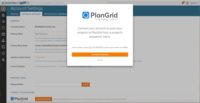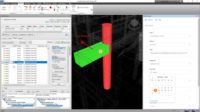Autodesk CEO Andrew Anagnost unveiled Autodesk AI at the company’s annual Autodesk University user conference Nov. 13, a new artificial intelligence-based tool now embedded in its products—including cloud-based conceptual design platform Forma and AutoCAD.
A week earlier, Nov. 6 to 8, and at the same Sands Convention Center at the Venetian Hotel in Las Vegas, cloud-based hardware and positioning system company Trimble made similar commitments and hosted the annual Cemex Construction Startup Pitch Day event at its user conference, Trimble Dimensions. The two weeks belied a sense of deja vu that has permeated construction technology with AI touching every aspect of design and delivery in the last year.
“For better or worse, AI has arrived with all the implications that are looming large for all of us,” Anagnost told attendees at Autodesk University, adding that challenges around inflation, supply chains and labor shortages are what has made AI necessary. Autodesk is investing in AI-enabled workflows that Anagnost said can save time for designers, contractors and anyone that uses their products.
Trimble's Karoliina Torttila—who has led the hardware and software company's efforts on AI and machine learning for a year now as director of AI—says construction use cases will be the focus of Trimble's efforts in AI. She added that the conceptual stage is the logical place to start to find tasks for AI to make work easier for human architects and engineers.
"The use of large language models in the user interface to our modeling software means that, instead of everybody having to learn SketchUp, or Tekla Structures, there's some really good work going on in the extension of of those two to a more natural language-based workflow," said Torttila who heads up Trimble's efforts from its Helsinki, Finland, office.
Anagnost promised that Autodesk’s AI tools will have open data structures and the company wouldn’t use them to exploit customer data. “Done badly, AI absolutely leads to bad outcomes,” Anagnost said. But, “if done well, it has the capacity to address the challenge of doing more with less.”
While Autodesk has had AI-based products such as Construction IQ for years, it recently acquired Blank.AI, which will initially allow automotive designers to rapidly iterate new 3D models and draw from old designs.
More Partnerships, More Data
Autodesk Forma now will use AI to automate design work for wind, noise and operational energy use during early planning stages. Amy Bunszel, Autodesk vice president AEC design, said every AEC customer now has access to Forma, which “is not Revit in a browser—it’s AI-powered design. Eventually, she said, Forma will expand beyond conceptual design to encompass the entire building information process. In order to reach that, Autodesk announced more data-sharing and interoperability agreements with its sometime competitors Trimble, Nemetschek and Ansys,as well as a deeper partnership with Esri to make all ArcGIS basemaps and Living Atlas data available in Autodesk’s products.
Getting all of that GIS data available in its products will take a heavy development lift, and Autodesk CTO Raji Arasu said both companies will work on connectors and similar efforts will happen for tie-ins with Nemetschek, Trimble and Ansys. Construction users of both Trimble and Autodesk products, both of which have cloud data sharing platforms, could be particularly useful as many contractors use aspects of both companies' tools.
Autodesk Docs, the common data environment running within Autodesk Construction Cloud will be a key data sharing repository, Anagnost said. Data in Autodesk Docs will be decoupled from the application where it was created so it can more freely move from one application to another, according to Jim Lynch, senior vice president of Autodesk Construction Solutions.
The agreement states “Trimble and Autodesk's collaboration demonstrates their ongoing commitment to support open industry standards such as Industry Foundation Classes (IFC) and Construction Operations Building Information Exchange (COBie), and can enable current and prospective Autodesk and Trimble customers working on the same projects to work together seamlessly through optimized file compatibility across applications."
According to agreement, Autodesk and Trimble will take steps to accelerate interoperability by exchanging application programming interfaces (APIs) and developer tools to build and market interoperable products.
Another Trimble Dimensions announcement, however, shows just how different the data and hardware manufacturer relationships Trimble has are from Autodesk's mainly designer-developed authoring tools.
Trimble and drone manufacturer Skydio announced an integrated workflow of data capture, data visualization, and data analytics addressing the needs surveying, mapping, and inspections. As part of the collaboration, which is in the "development stage," Skydio drones will be integrated with GNSS receivers and software from Trimble.
If both companies follow through with their API integrations it could mean easier transfer of Skydio's reality capture data into Autodesk's Construction Cloud platform from the workflow of Skydio Cloud to Trimble Industry Cloud.
Extending Reality
Autodesk’s 2022 acquisition of extended reality environment The Wild was on display in its next version, Autodesk Workshop XR, with capabilities for virtual meetings inside of Revit 3D models. Autodesk’s current approach to data and data-sharing now differs from how the company approached it in the past, said Anagnost.
“We are a subscription and consumption company,” he explained.“We will use those capabilities in new and interesting ways.” He added that users want to move their data between their tools, and Autodesk will help facilitate that with its new interoperability agreements.
All of the data work within Autodesk's cloud and in agreements with other cloud providers is still focused on Forma becoming more than just a conceptual design tool, Anagnost said.
“It’s a lot easier to build a robust infrastructure in a conceptual phase, which is highly collaborative, and depends on a lot of different types of capabilities,” said Anagnost. “It doesn’t conflict with what Revit does. What you do is, over time, you start moving Forma closer to Revit, and Revit closer to Forma, which is very similar to what we did with Fusion on the manufacturing sides when we started it.”






Post a comment to this article
Report Abusive Comment